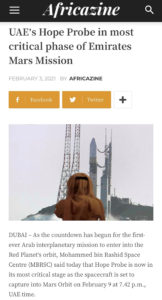UAE’s Hope Probe In Most Critical Phase Of Emirates Mars Mission: AFRICAZINE
AFRICAZINE, one of the most widespread websites in the African continent has published a detailed report on the historic mission of the Hope probe as part of the Emirates Mars Mission (the Hope Probe) to reach Mars.
The report confirmed that the Hope Probe, developed by Emirati minds to carry out the first Arab Mars mission, will provide humanity with unprecedented historical information about the Red Planet.
The report noted that as the countdown has begun for the first-ever Arab interplanetary mission to enter into the Red Planet’s orbit. The Mohammed bin Rashid Space Centre (MBRSC) said today that Hope Probe is now in its most critical stage as the spacecraft is set to capture into Mars Orbit on 9th February, 2021, at 7:42 UAE time.
The report quoted Omran Sharaf, Project Director of Emirates Mars Mission during the MBRSC’s media briefing today as saying that the Mars Orbit Insertion (MOI) is at the risky stage when the Hope Probe will have to slow down sufficiently to be captured into the Mars Orbit. As it approaches the Mars orbit, the spacecraft will use its thrusters to reduce its speed.
“Precision is fundamental to success to avoid, God Forbid, Hope Probe crashing on Mars or missing its orbit and getting lost in deep space,” he added.
“The design, system and software that will be used for the MOI are all Emirati-made. This is in line with the directive from the UAE leadership to build and not to buy,” he added.
The complex manoeuvre on 9th February will be the most critical part of the mission that will see the spacecraft rapidly reducing its speed from 121,000km/h to 18,000km/h to enter the orbit of Mars.
The report tackled in detail the journey of the Hope Probe from the launch to its arrival in the Mars orbit after travelling 493 million kilometres in a seven-month journey since its launch on 20th July, 2020, from Tanegashima Island in Japan, the probe will provide the first-ever complete picture of the Martian atmosphere.
It also mentioned that the unmanned spacecraft will explore the climactic dynamics of the Red Planet in daily and seasonal timescales for a full Martian year (687 earth days), an endeavour that has never been pursued by any previous mission.
Since its launch from Tanegashima Space Centre in southwestern Japan, on a Mitsubishi MH-IIA rocket, the Hope probe has completed the launch and early operation stages – two of the six stages of its journey. The spacecraft is approaching the end of the third and longest stage, the cruise, which saw three successful manoeuvres to keep the probe on track towards its Mars destination. On February 9, 2021, the probe will enter its fourth, and most critical stage of its journey. The following two stages, the “transition to the Science Orbit” and the “Science Orbit” will see the probe carrying out its exploration mission to study the atmospheric dynamics and weather of the Red Planet.
Global Picture of Martian Atmosphere: Once it reaches the Mars’ orbit, the Hope Probe will provide the first-ever complete picture of the Martian atmosphere, monitoring weather changes throughout the day during all seasons, which has not been done by any previous mission.
The mission will provide deeper insights on the climatic dynamics of the Red Planet through observing the weather phenomena in Mars such as the massive famous dust storms that have been known to engulf the Red Planet, as compared to the short and localised dust storms on earth. It will focus on better understanding the link between weather changes in Mars’ lower atmosphere, with the loss of hydrogen and oxygen from the upper layers of the atmosphere. The probe, for the first time, will study the link between weather change and atmospheric loss, a process that may have caused the Red Planet’s surface corrosion and the loss of its upper atmosphere.
Exploring connections between today’s Martian weather and the ancient climate of the Red Planet will give deeper insights into the past and future of Earth and the potential of life on Mars and other distant planets.
The report also said that the probe will gather and send back 1,000 GB of Mars data to the Science Data Centre in the UAE via different ground stations spread around the world. The data will be catalogued and analysed by the Emirates Mars Mission science team and shared for free with the international Mars science community as a service to human knowledge.
It also added that the announcement had set in motion a historic moment not just for the UAE, but the entire Arab world. It had signalled a shift in the development journey of the UAE through its entry to the global space race where the knowledge and capabilities of the UAE nationals and residents are the true wealth of the nation. The project is not only about sending a probe to Mars – it represents greater hope for the region in empowering the youth in the fields of science and technology.
The probe was 100 percent indigenously manufactured, enabling young Emirati scientists and engineers to take on a massive challenge in the new field of space. The young team was trained and prepared to take on projects in the space sector as an opportunity to build new national capabilities and build a sustainable infrastructure for space technologies in the country, in collaboration with global partners, the report said in conclusion.







